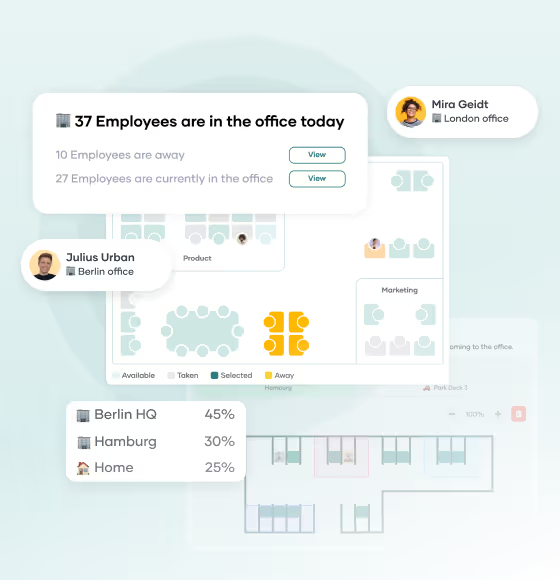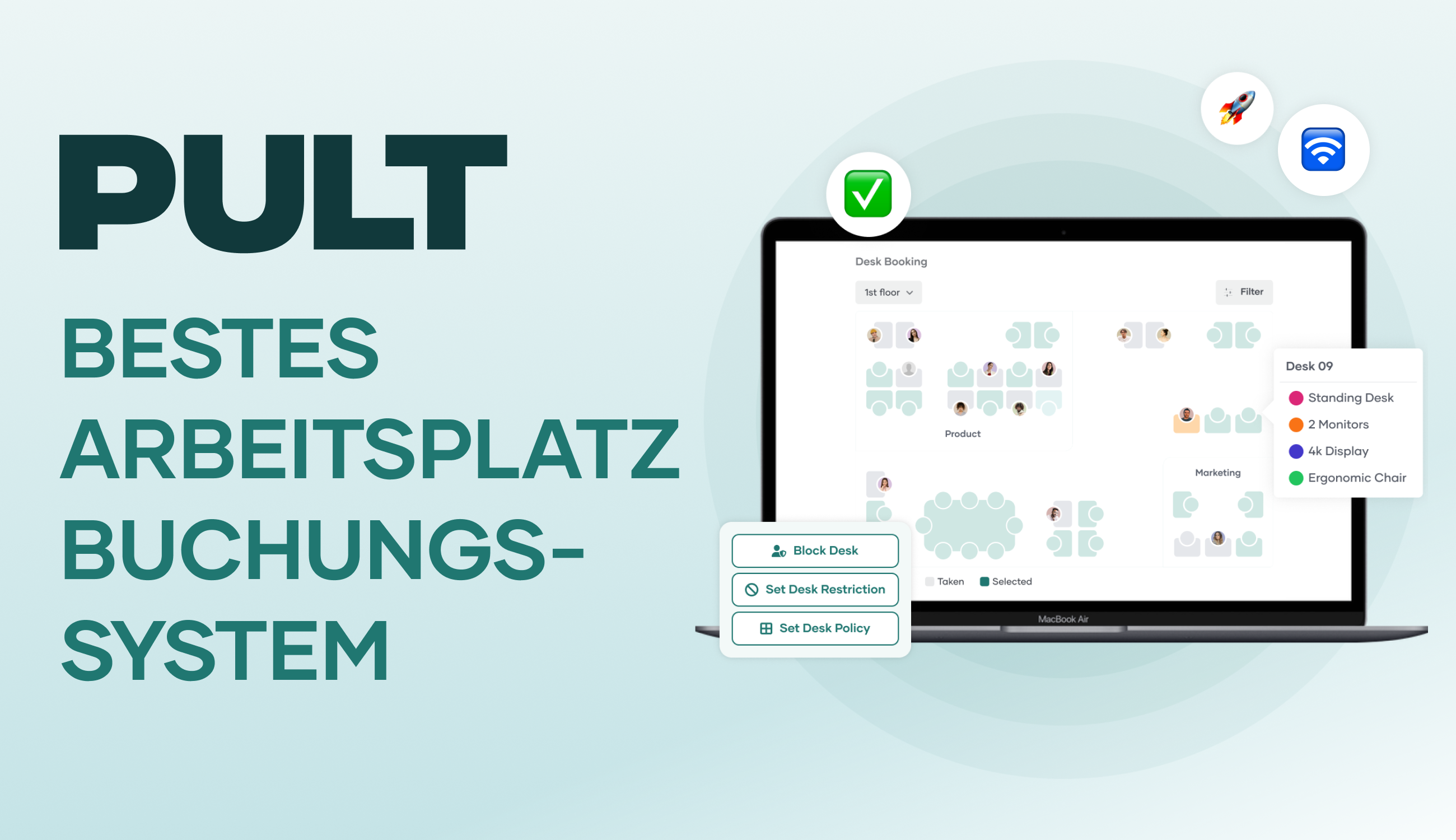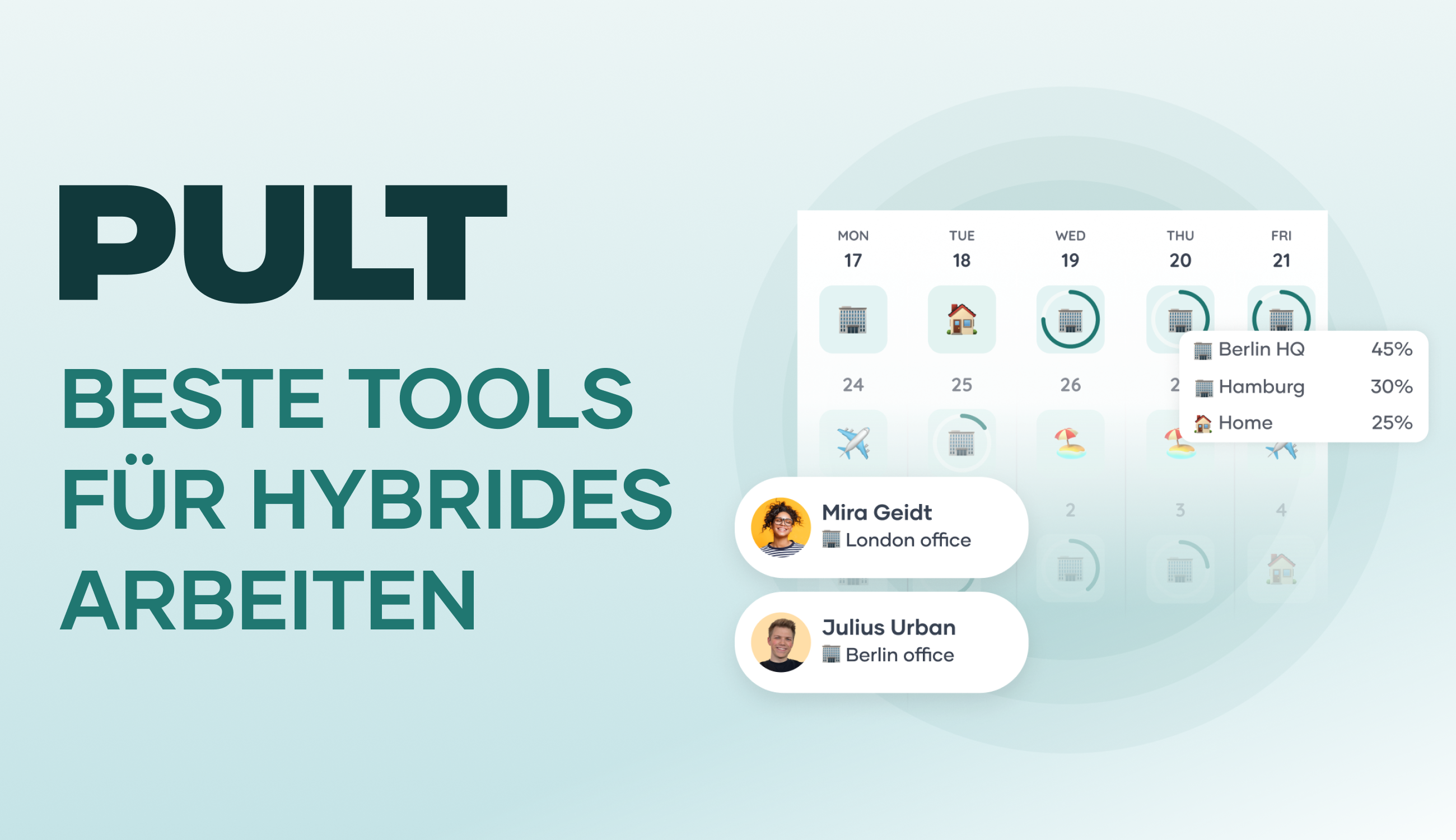Shared Workspace: Advantages, Disadvantages, Costs

Shared workspace: What are the advantages over having your own office?
Offices are no longer fully utilised. According to the Federal Statistical Office, 23.5% of all employees now work from home at least occasionally, almost twice as many as before the pandemic (2019: 12.8%). Shared workspaces are a pragmatic response to this changed working reality. The concept is simple: several users share workspaces and the associated infrastructure. In this article, you will find out what a shared workspace is, what different forms there are and how they differ from other workplace concepts.
What is a shared workspace?
A shared workspace is a workspace that is shared by several users and companies, either simultaneously or at different times. In contrast to traditional offices, where one company is the sole tenant of an enclosed space, workspaces, rooms or entire zones can be used alternately as required. The users share the infrastructure: Wi-Fi, printers, meeting rooms, kitchen and often also services such as reception or cleaning.
The user structure is diverse: self-employed people, small companies, project teams or employees of larger organisations who temporarily need a fixed place to work. Teams that only meet physically on certain days also use shared workspaces for selective organisation without having to provide permanent space.
Differentiation: shared workspace vs. coworking vs. own office
The term "shared workspace" is often mistakenly equated with coworking. In fact, there are clear differences:
Coworking focuses on an open, network-orientated work culture. The exchange between different industries and people takes centre stage. Coworking spaces are usually open-plan, offer events and deliberately promote community building. There are rarely fixed workstations.
Shared workspaces are designed to be more functional: workspaces with a structure that can be booked, shared and scaled, but without an explicit community focus. This is primarily about the cost-efficient, shared use of office infrastructure, not networking.
Own offices offer maximum control and privacy, but require long-term leases and high fixed costs. According to CBRE Germany, the average rental costs for office space in German A-cities are at least 15-25 euros per square metre per month - plus ancillary costs, furnishings and administrative expenses.
Shared Workspace
- Flexibility: High (bookable by the day / month)
- Community focus: Low
- Predictability: Medium
- Costs: €200 – €600 per seat per month
- Equipment: Fully inclusive
Coworking
- Flexibility: Very high (bookable by the hour)
- Community focus: High
- Predictability: Low
- Costs: €20 – €50 per day
- Equipment: Fully inclusive
Own Office
- Flexibility: Low (mostly annual contracts)
- Community focus: None
- Predictability: High
- Costs: €800 – €1,500 per seat per month
- Equipment: Must be procured by yourself
What types of shared workspace are there?
Shared workspace is not a standardised concept, but a collective term for four main types: Coworking-style areas (open workspaces without fixed places), business centres (enclosed office spaces with shared services), office sharing (office communities through subletting) and hybrid solutions (mixed forms). The various models are aimed at different target groups and needs.
Coworking-style areas
Open workspaces in which different people and companies work side by side without a fixed allocation of space. The atmosphere is informal and dialogue is encouraged, but not mandatory. In addition to workstations, there are usually common rooms, telephone booths and sometimes events.
Typical users: Self-employed people, start-ups, mainly mobile teams, individuals with a need for professional infrastructure.
Business centre
Closed office spaces of very different sizes that are shared by several companies or teams. The rooms are clearly demarcated and the meeting room, reception and kitchen are shared. Often with additional services such as mail reception, telephone service or secretarial services.
Suitable for: established companies that require representation, teams with confidentiality requirements, consultancies.
Office sharing
Traditional shared offices where a main tenant sublets vacant space to other companies. Often arise when companies have space left over after downsizing, mergers or an increased proportion of home offices. The costs are usually divided up via a simple allocation of ancillary costs.
Particularly common in large cities where office space is scarce and therefore expensive.
Hybrid approaches
Mixed forms that combine elements of different models. For example, business centres with optional coworking areas or office-sharing communities with additional space for growing teams. These models often emerge organically when providers and landlords respond to customer needs.
However, the boundaries are becoming increasingly blurred as providers adapt their concepts to local demand.
Advantages and disadvantages of shared workspace
Shared workspaces cost less than dedicated offices, but require a premium for flexibility. They are usually cheaper for short-term use (less than 2 years) or fluctuating team sizes. However, if you need the same space consistently over the long term, you are better off with your own rental agreement.
Costs of a shared workspace
Shared workspaces significantly reduce office costs. Office rental prices in major German cities are around 24-29 euros per square metre per month: Berlin at 29 euros/m², followed by Munich at 24.70 euros/m² and Frankfurt (24.30 euros/m²). With an average of 10-15 square metres per workspace, basic rental costs range from 240 to 435 euros per month, plus ancillary costs, furnishings and administration. In contrast, shared workspaces often offer a more favourable complete solution without additional investment.
The disadvantage of a shared workspace is that the greater flexibility comes at an additional cost. Shared workspace providers factor in vacancy, service and profit margin. With long-term, constant use, your own office can become cheaper.
Balancing act between the flexibility and predictability of a shared workspace
Shared workspaces allow for quick adaptation in the event of fluctuating team sizes or project phases. Teams can book additional workspaces as required or reduce the number of workspaces during quieter phases. This is a clear advantage, especially for project-based companies or start-ups with unpredictable growth.
At the same time, uncertainties arise: Popular spaces or rooms are not always available. In high-demand locations, users report booking problems, especially on Mondays and after school holidays. Some providers solve this problem with waiting lists or premium memberships with guaranteed spaces.
Tip: In the booking software PULT, users of the shared workspace can book their workspace in advance, directly from their smartphone.
Distraction and productivity in a shared workspace
Open shared workspaces can impair concentration. Conference calls, conversations with other users and changing workstations can be distracting. Users report more frequent interruptions than in their own offices.
On the other hand, many users report increased motivation due to the professional working atmosphere compared to working from home or in the same office.
Organisation and administration of shared workspaces
The shared use of workspaces brings with it administrative challenges that do not exist with private offices. Providers have to coordinate bookings, monitor utilisation and avoid conflicts between users.
Without systematic organisation, problems quickly arise: Double bookings, unclear availability and disputes over coveted spaces.
A survey conducted by the Federal Association of Coworking Spaces Germany in 2023 showed that 34% of users have already experienced situations in which booked workspaces were already occupied or meeting rooms were double-booked. This leads to planning uncertainty and frustration, especially in highly sought-after locations.
Most professional providers therefore rely on digital booking systems. This software enables real-time availability checks, prevents double bookings and provides clarity about the actual free capacities. Users can check in advance and make binding reservations, while providers receive detailed utilisation data to optimise their space.
Modern booking and management tools such as the PULT software integrate desk booking, room management and visitor management in a standardised platform. PULT runs entirely in the browser and therefore works on any device, from smartphones and laptops to desktop PCs.
Providers of shared workspaces receive detailed usage statistics and can see in real time which areas are in high demand and where capacity is still available. This data helps with decisions about expanding or reorganising space. Users benefit from a particularly simple booking experience without phone calls or emails: from individual workspaces to conference rooms, all in one application.
{{cta}}
Shared workspaces - frequently asked questions and answers
Can I only use a shared workspace on a daily basis?
Yes, most providers offer day passes for 25 to 60 euros. Many also offer weekly or 10-user passes, which are cheaper than individual day passes.
How secure is my data in a shared workspace?
Always use a VPN and never work without a screen lock. Most reputable providers have separate networks and security policies, but ultimately the responsibility for your data lies with you.
Can I receive clients in a shared workspace?
Most providers allow client visits, but require pre-booking. You should book a separate meeting room for important appointments, as open areas can often come across as noisy and unprofessional to your guest.
How are the costs of a shared workspace divided between the companies?
There is usually one main tenant who rents the entire space and allocates the costs to the other companies based on workstations or square metres. Communal areas such as kitchens or meeting rooms are charged on a pro rata basis.
What happens if a company moves out of the shared workspace?
The main tenant should then quickly find a replacement or temporarily bear the costs alone. For this reason, fixed-term subletting agreements are often concluded with notice periods of 3 to 6 months.
A new hybrid workplace experience is coming. Start Now. 🎉





















.avif)





